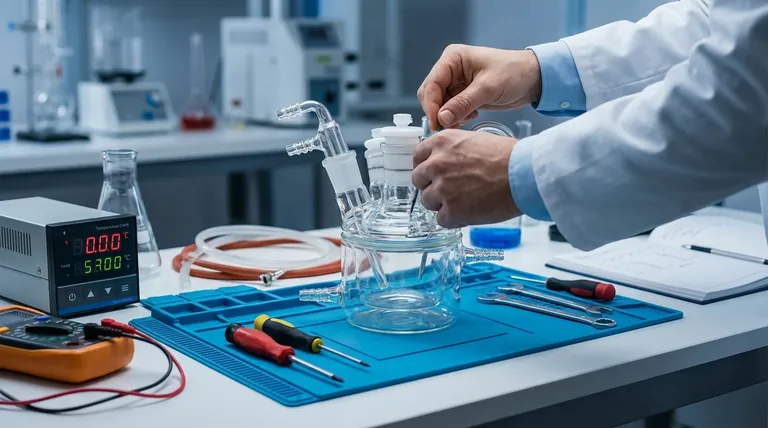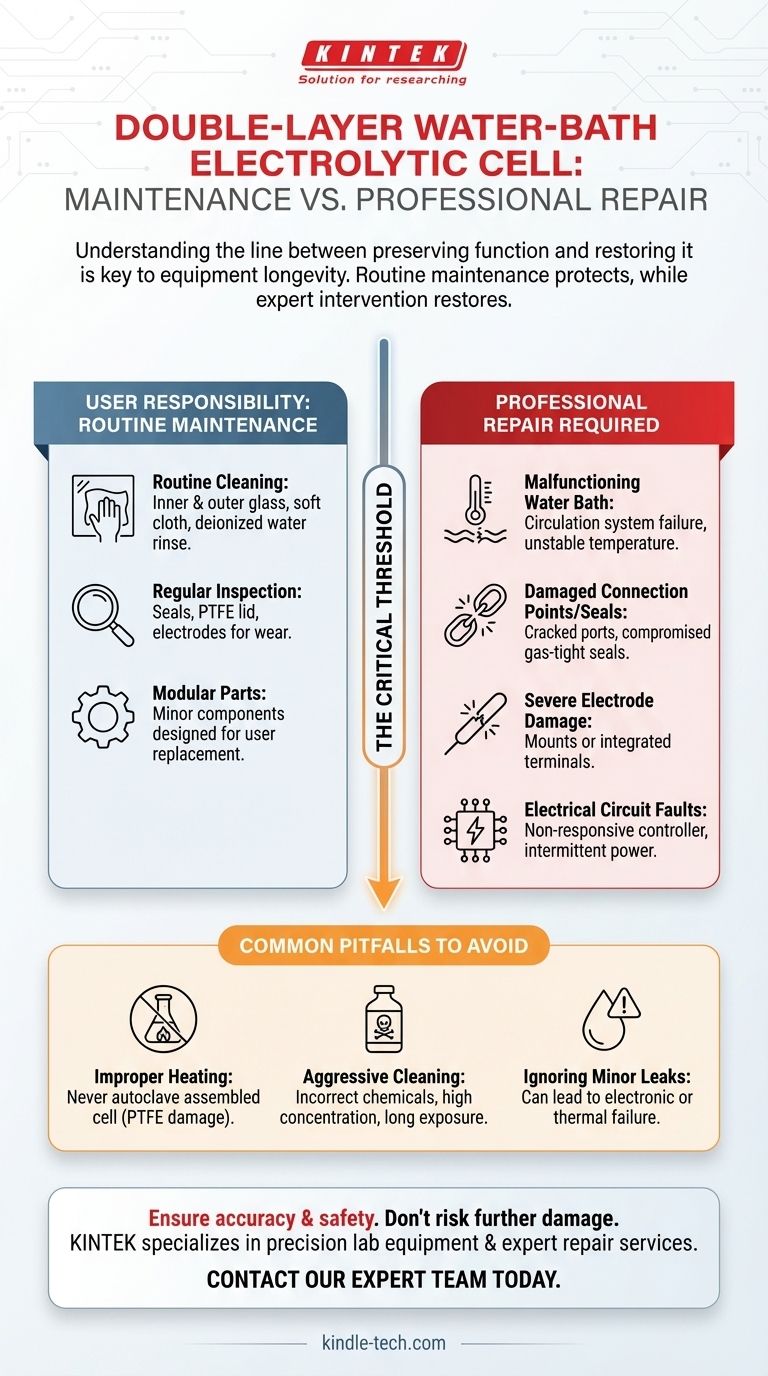Knowing when to seek professional repair for your double-layer water-bath electrolytic cell is crucial for maintaining experimental integrity and preventing costly damage. You should engage a professional technician for any issue affecting the core integrated systems, such as a malfunctioning water bath circulation system, damaged electrical connection points, compromised seals, or any internal circuit faults. Attempting to fix these complex problems yourself often leads to greater damage.
While routine cleaning and inspection are the user's responsibility, any failure that compromises the system's structural, thermal, or electrical integrity requires expert intervention. This distinction is key to protecting the equipment and the validity of your results.

The Line Between Maintenance and Repair
Understanding the boundary between user-level care and professional service ensures your equipment operates reliably. The core principle is simple: maintenance preserves function, while repair restores it after a failure.
User Responsibility: Routine Maintenance
Your role involves regular inspection and cleaning to prevent buildup and catch minor issues early.
The glass cell body is fragile and must be handled with care at all times to prevent breakage or chipping.
Regularly clean the inner and outer surfaces with a soft cloth to remove dirt and electrolyte residue. For stubborn deposits like metal oxides, a careful chemical cleaning using a specified reagent (e.g., dilute acid) may be necessary. Always rinse thoroughly with deionized water afterward.
Inspect seals, the PTFE lid, and electrodes for signs of wear or degradation. Minor, modular components are often designed for user replacement.
The Critical Threshold: When to Call an Expert
Certain failures indicate a problem beyond routine maintenance. Do not attempt to disassemble the unit if you observe these issues.
Malfunctioning Water Bath Circulation: The primary function of the double-layer design is precise temperature control. If the external circulation system fails, the cell cannot maintain a stable temperature, rendering temperature-sensitive experiments invalid. This often points to a pump or controller issue requiring professional service.
Damaged Connection Points or Seals: The integrity of electrical connections and gas-tight seals is paramount. If connection ports are cracked or seals are compromised in a way that user-replacement is not possible, the system's safety and containment are at risk.
Severe Electrode Damage: While routine electrode replacement is normal, severe damage to the electrode mounts or integrated terminals within the cell head requires professional repair to ensure proper electrical contact and sealing.
Electrical Circuit Faults: Any sign of electrical failure, from a non-responsive controller to intermittent power, is a significant risk. These issues point to faults within the internal circuitry and must be diagnosed by a qualified technician.
Common Pitfalls to Avoid
Certain user errors can directly lead to damage that necessitates professional repair. Being aware of these common mistakes is a critical part of proper equipment stewardship.
Improper Heating and Sterilization
The glass components may be autoclavable, but the entire assembled cell must never be heated or sterilized at high temperatures.
The PTFE lid, in particular, will expand when heated and may not return to its original shape, permanently damaging the seal. This is a common and costly user error.
Aggressive Cleaning
When performing chemical cleaning, using an incorrect chemical, an overly high concentration, or leaving it for too long can etch or weaken the glass. This can compromise the structural integrity of the cell over time.
Ignoring Minor Leaks
A small leak from a seal or fitting may seem insignificant, but it can allow fluid to reach sensitive electronic components or cause a loss of thermal stability. Address minor issues promptly before they escalate.
Making the Right Decision
Use this framework to guide your actions and protect your equipment.
- If your primary focus is routine upkeep: Regularly inspect all components and perform gentle cleaning as specified by the manufacturer.
- If you observe a system-level failure (temperature, electrical, circulation): Immediately stop all use and contact a professional technician for diagnosis and repair.
- If you discover physical damage to the core structure (glass body, ports): Do not use the cell and seek an expert assessment to determine if a repair is feasible.
Ultimately, treating your electrolytic cell with care and respecting its operational limits is the best way to ensure its longevity and the accuracy of your work.
Summary Table:
| User Maintenance | Professional Repair Required |
|---|---|
| Routine cleaning of glass body | Malfunctioning water bath circulation system |
| Inspection of seals & electrodes | Damaged electrical connection points or ports |
| Replacement of simple modular parts | Compromised seals requiring specialized tools |
| Chemical cleaning of deposits | Internal electrical circuit faults |
| Checking for minor wear | Severe damage to electrode mounts or cell head |
Ensure the accuracy and safety of your experiments. Don't risk further damage to your electrolytic cell.
KINTEK specializes in precision lab equipment and consumables, providing expert repair services for double-layer water-bath electrolytic cells and other critical laboratory instruments. Our technicians have the expertise to diagnose and fix system-level failures, restoring your equipment's performance and protecting your research integrity.
Contact our expert team today for a professional assessment and reliable repair service.
Visual Guide

Related Products
- Double Layer Five-Port Water Bath Electrolytic Electrochemical Cell
- Double-Layer Water Bath Electrolytic Electrochemical Cell
- H-Type Double-Layer Optical Electrolytic Electrochemical Cell with Water Bath
- Multifunctional Electrolytic Electrochemical Cell Water Bath Single Layer Double Layer
- Electrolytic Electrochemical Cell for Coating Evaluation
People Also Ask
- What precautions should be taken regarding temperature control for the electrolytic cell? Ensure Safe & Accurate Electrolysis
- When is chemical cleaning necessary for an electrolytic cell, and how should it be performed? A Guide to Removing Stubborn Deposits
- What inspection steps should be performed before using the electrolytic cell? A Guide to Safe & Accurate Experiments
- What regular inspection and maintenance activities are required for the electrolytic cell? Ensure Reliable Results & Extend Equipment Life
- How should a double-layer water-bath electrolytic cell be operated? A Step-by-Step Guide for Reliable Results



















